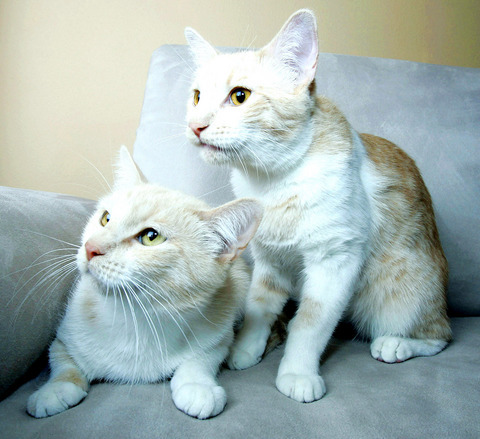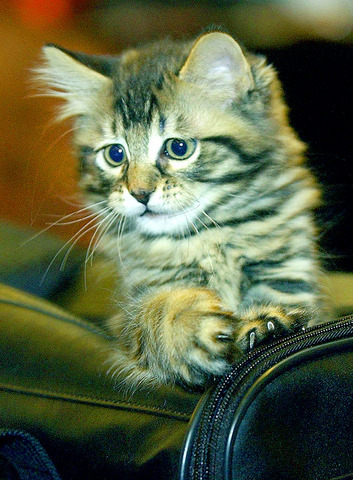Ordinarily it is hard to predict how a kitten will look when it is grown. But not for David Cheng, who plans to buy a clone of his much-loved, short-haired black-and-white cat, Shadow. After all, the cloning company guarantees that Shadow's successor will bear a close resemblance.
When Cheng, who works as a technology auditor for a Wall Street investment bank, discovered that Shadow had a tumor that would soon prove fatal, he had the cat's cells saved, cultured and frozen. Now he is preparing for the next step: paying for Shadow's cloned replacement.
"I'm saving up some money," he said. "It's a lot like buying a car."

PHOTO: NY TIMES NEWS SERVICE
The financing for Shadow's successor won't be trivial. Preserving the cells, a necessary beginning for anyone interested in creating a clone, can run US$300 to US$1,400, not including veterinarian costs and yearly storage fees. But these expenses pale in comparison with the cost of the cloning itself. At Genetic Savings and Clone, the company that stored Shadow's DNA, the price is US$32,000, reduced from the original US$50,000, but still an impressive sum.
Cheng said that he would pay whatever it cost -- although he is waiting until the price drops a bit -- because he misses his cat so.
"Shadow had two really long, funny-looking teeth like sabers," he said. "Everyone loved him."

PHOTO: AP
The cloning and sale of pets has its critics, who call it wasteful and inhumane. Some point to shelters bursting with pets in need of homes, or remind buyers that cloning is still a relatively new process, with the health of future generations of offspring still unknown. And the US$32,000 lavished on one kitten clone would certainly pay for the care of many a needy animal.
But Kathy Hudson, director of the Genetics and Public Policy Center at Johns Hopkins University, said affection for lost pets was a powerful motivator.
"People pay outrageous sums for unusual breeds and purebreds and, now, clones," she said. "Some people become adoring of a particular pet and want another one exactly like it."
Cheng is one of hundreds of customers of Genetic Savings and Clone in Sausalito, California, who have already banked samples of pet DNA, said Ben Carlson, a company spokesman. People sign up for many reasons, sometimes because their animals have been spayed or neutered and can't be bred, or because they were the product of a unique genetic cocktail the company calls a "breed of one."
"We have many people whose pet is a mutt with the perfect blend of characteristics," Carlson said. "That person can't go to a breeder, but he can get what amounts to an identical twin from us."
Right now, Genetic Savings is selling only cat clones, although Lou Hawthorne, the chief executive, said the company would probably produce its first cloned dog this year. So far, the company has sold two cat clones at US$50,000 each and has sent out several contracts under the new, reduced price, which it plans to lower again as the cloning process becomes more efficient.
To display its work and perhaps to help demystify its science, the company is opening a 740m2 research site outside Madison, Wisconsin. It will have plate-glass windows set into the U-shaped perimeter of a laboratory so that people can view this modern version of a maternity ward.
They may also catch a glimpse of a local cat celebrity, Peaches, cloned last year from Mango, owned by Leslie Ungerer, who oversees most of the feline projects at the lab.
"They are fast friends," she said of mother and clone, who spend part of their time at the lab and part at her home.
Hawthorne said all clones come with a one-year health guarantee. And, "We give an absolute, money-back guarantee for physical resemblance," he said.
Dog owners can hardly wait. About 200 of them have signed up at Genetic Savings to preserve their pets' DNA. Rebecca Alford, an opera singer who lives in Manhattan, has stored cells from her dog Missy, a Maltese mix, now dead. Today Alford has five dogs, including two purebreds (one Shih Tzu and one Maltese) she rescued when they were abandoned on the street. But they have not replaced Missy, she said.
"I probably would have had her bred, but I did the responsible thing and had her spayed," she said. "I won't get Missy back, but it will be like getting her puppies."
People who want to save their pets' DNA usually start the process with a visit to a veterinarian, who collects the tissue and mails it to Genetic Savings. Then the company cultures the cells, taking samples and growing new cells, in a process that takes about three weeks and costs about US$900, said Philip Damiani, the chief scientific officer. Then the cells are frozen and stored in liquid nitrogen. After the first year, an annual US$100 storage fee is charged.
For a lower price -- US$295 -- customers can simply store biopsy samples and wait until they are ready to clone to have the culturing done. Hawthorne said business had been brisk for both the stripped-down process and the more elaborate cell banking, and the procedures are almost always successful.
"Most of the time, the tissue grows well in culture," he said. "The marginal situations are when someone calls and says they buried their dog three days ago."
Damiani said the procedures that people would be able to see in the display laboratory were straightforward and would show that the animals were treated well. The company receives cat reproductive tracts by contract from large spay clinics. Eggs are taken from the tracts and the DNA is removed. DNA from the animal to be cloned is placed in the egg, which is then grown into an embryo.
"Once the egg is formed, we do a surgical procedure," he said, placing the embryo inside a surrogate cat mother. "The procedure is no more invasive than a typical spay."
That is not the view of Crystal Miller-Spiegel, senior policy analyst at the American Anti-Vivisection Society, in Jenkintown, Pennsylvania, a Philadelphia suburb.
"We are concerned about what's happening to cats in laboratories," she said. "They are harming animals for no reason."
The society is a founding member of Californians Against Pet Cloning, a group that supports legislation to ban the sale of genetically modified and cloned animals.
Indeed, ethical issues like the treatment of animals used for cloning will need to be addressed systematically, said Lori Gruen, an associate professor of philosophy at Wesleyan University, particularly as cloning grows more efficient and therefore less expensive and as its popularity expands.
"There are legitimate ethical worries that people are expressing about the suffering of animals," she said. "But these problems can be adequately addressed with an appropriate oversight body."
Such debates mean little to Cheng, who has a second cat named Nana that looks a lot like Shadow and is one reason he has not opted to clone immediately.
"I have to think about the other cat; she might not like having another cat," he said of Nana, now eight years old. "After she passes away, I may start all over again with one new Shadow and one new Nana."

On April 26, The Lancet published a letter from two doctors at Taichung-based China Medical University Hospital (CMUH) warning that “Taiwan’s Health Care System is on the Brink of Collapse.” The authors said that “Years of policy inaction and mismanagement of resources have led to the National Health Insurance system operating under unsustainable conditions.” The pushback was immediate. Errors in the paper were quickly identified and publicized, to discredit the authors (the hospital apologized). CNA reported that CMUH said the letter described Taiwan in 2021 as having 62 nurses per 10,000 people, when the correct number was 78 nurses per 10,000

As Donald Trump’s executive order in March led to the shuttering of Voice of America (VOA) — the global broadcaster whose roots date back to the fight against Nazi propaganda — he quickly attracted support from figures not used to aligning themselves with any US administration. Trump had ordered the US Agency for Global Media, the federal agency that funds VOA and other groups promoting independent journalism overseas, to be “eliminated to the maximum extent consistent with applicable law.” The decision suddenly halted programming in 49 languages to more than 425 million people. In Moscow, Margarita Simonyan, the hardline editor-in-chief of the

Six weeks before I embarked on a research mission in Kyoto, I was sitting alone at a bar counter in Melbourne. Next to me, a woman was bragging loudly to a friend: She, too, was heading to Kyoto, I quickly discerned. Except her trip was in four months. And she’d just pulled an all-nighter booking restaurant reservations. As I snooped on the conversation, I broke out in a sweat, panicking because I’d yet to secure a single table. Then I remembered: Eating well in Japan is absolutely not something to lose sleep over. It’s true that the best-known institutions book up faster

Though the total area of Penghu isn’t that large, exploring all of it — including its numerous outlying islands — could easily take a couple of weeks. The most remote township accessible by road from Magong City (馬公市) is Siyu (西嶼鄉), and this place alone deserves at least two days to fully appreciate. Whether it’s beaches, architecture, museums, snacks, sunrises or sunsets that attract you, Siyu has something for everyone. Though only 5km from Magong by sea, no ferry service currently exists and it must be reached by a long circuitous route around the main island of Penghu, with the